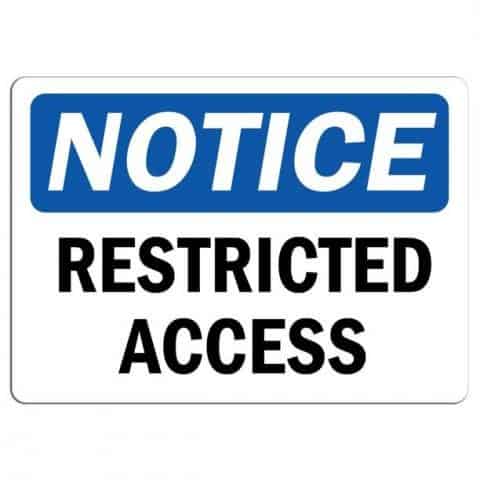Mold & Misunderstandings: What Does It Mean?

Late in 2018, mold was discovered on some light fixtures and storage boxes located inside a lab’s cold room at Pacific Northwest National Laboratory (PNNL).
Until the mold could be remediated from the cold room, the building manager placed a sign on the door of the cold room that read “Notice-Restricted Access-Contact building manager Prior to Access” and placed yellow caution tape over the cold room door handle.
Several months later, a facility specialist entered the lab and observed researchers inside the restricted access cold room. The facility specialist asked the researchers to leave the cold room due to the previously discovered mold issue and pointed to the restricted access sign posted on the door. The researchers promptly expressed their concern to management and the lab’s Cognizant Space Manager (CSM) about less than adequate communication regarding the cold room mold issue and restricted access notice.
This issue could have been avoided to begin with
After learning about the researcher’s entry to the restricted access cold room, the building manager asked the facility specialist to put red danger tape on the cold room door; based on his assumption the restricted access sign was disregarded. The building manager then reported the matter to the PNNL Security Operations Center as it was his expectation staff would contact him for approval before trying to access the cold room.
The details
Further examination of the matter revealed the researchers had obtained approval to enter the restricted access cold room. When the researchers first saw the restricted access sign and yellow caution tape on the door, they contacted the lab’s CSM about retrieving some samples from the cold room. The CSM in turn contacted building management about accessing the cold room. The building manager told the CSM he needed to work with the Worker Safety and Health (WS&H) Representative to be sure there were no safety concerns associated with retrieving samples.
Following air monitoring, WS&H notified the CSM that the researchers could enter the cold room. The permission was communicated via email to the CSM; cautioning the amount of time in the cold room was to be minimal to minimize any risk of exposure. With WS&H permission to enter the cold room for short periods of time, the CSM interpreted that to mean the approval applied until the access restriction was lifted. The CSM then verbally communicated the WS&H entrance guidance with the research staff. However, the “Notice-Restricted Access” sign remained on the door.
The facility specialist was unaware of the previous direction given by the WS&H Representative and contacted the building manager for clarification of the signage and expectation. When the researchers returned a second time to collect samples, they observed red danger tape on the cold room door. Concerned over the meaning of the red danger tape, the researchers again reached out to the CSM. The researchers and the CSM later learned the red danger tape was not related to any new hazard, but was in reaction to the building manager’s misunderstanding that the researchers had intentionally disregarded the Restricted Access Area signage and yellow caution tape.
Lessons learned
While it’s obvious all involved had good intentions, providing clear communication is key. Clearly conveying detailed information about the reason for the restricted access to the cold room, as well as assuring all staff who had access to the lab were aware of that reason, would have gone a long way in preventing miscommunications among the researchers, WS&H, and building management.
Below are a few tips PNNL provided to help assure that the message was clear and staff were duly informed.
- Avoid vague signage on restricted or limited access spaces. Make sure the signage is clear and the language does not covey unintended messages. If the intent or message is not clear, the reader should contact the creator of the posting for additional guidance.
- Clearly explain the intent of signs, including safety warnings and procedures for entering restricted or limited access spaces; verbally and/or in writing. Avoid making assumptions or interpretations of postings. If the intent or message is not clear, the reader should contact the creator for additional guidance.
- Make sure the signage and verbal and/or written messaging is relayed to all who may have reason to access the space (e.g. staff with access, line and building management, relevant CSM, and WS&H Representative).
This Lesson Learned is from Pacific Northwest National Laboratory (PNNL), Operating Experience. Courtesy of OPEXSHARE, U.S Department of Energy.
Register today for a TapRooT® Root Cause Analysis Training Course
TapRooT® training is global to meet your needs. If you need particular times or locations, please see our full selection of courses.
If you would like us to teach a course at your workplace, please reach out to discuss what we can do for you, or call us at 865.539.2139.
Stay engaged with your skills and training: Follow along on our blog; join our Wednesday TapRooT® TV videos at 2 pm EST; connect with us on Facebook, Twitter, Instagram, Pinterest, LinkedIn, and YouTube.
Get your team ready for the one conference you must attend in 2021
The 2021 Global TapRooT® Summit, June 14-18, 2021, in Knoxville, Tennessee, is the best setting to help you develop your roadmap to success. You will also meet industry leaders and network with other professionals.
Look through the 2021 Global TapRooT® Summit schedule to browse the tracks and then . . .
- Peruse and take advantage of the Pre-Summit Courses (June 14-15).
- Read Summit FAQ.
- Save money! Register 3 or more attendees simultaneously for a discount. Also, save when you register for the 3-day Summit plus a 2-day Pre-Summit course.



